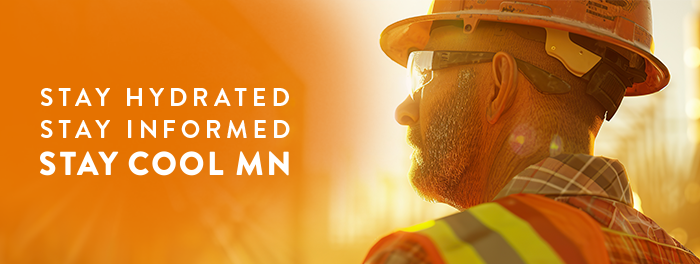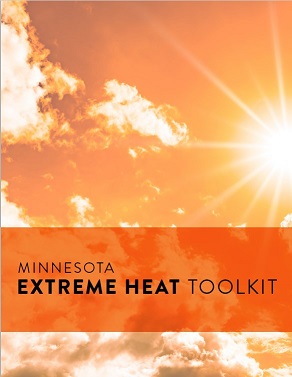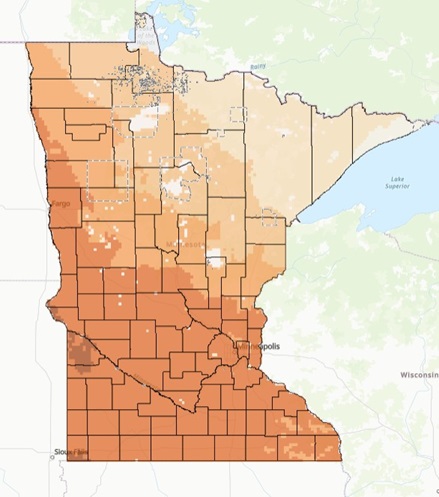
Planning for and Responding to Extreme Heat
Extreme heat causes more deaths in the U.S. than flooding, tornadoes, and hurricanes combined. In the years ahead, extreme heat events are expected to become more common, more severe, and last longer due to climate change.
Heat-related illnesses and deaths are largely preventable. With appropriate planning, education, and action, communities can reduce negative health impacts. This page contains resources and guidance to help Minnesota communities prepare for and respond to extreme heat. It's designed for: people who plan for the safety of their community, including community and government leaders, local public health planners, emergency managers, and others.
The Minnesota Extreme Heat Toolkit

Local public health staff, emergency managers, and community leaders can play a key role in helping Minnesotans stay safe during days of extreme heat. The Minnesota Extreme Heat Toolkit (PDF) contains flexible heat safety strategies and guidance to meet the unique needs of Minnesota communities. Chapter 1 defines heat warnings, explores the health impacts of extreme heat (PDF), and covers factors that increase the risk of heat-related illnesses, including demographics, preexisting conditions, drugs and medications, social and behavioral influences, insufficient built environments, and geographic considerations. Chapter 2 offers tools to inform decision-making and how to initiate a community-wide heat response. Chapter 3 includes social media messages, public service announcements, and a sample news release.
Heat & Health Interactive Map

The Heat & Health Interactive Map is a powerful data-driven tool to help emergency managers, planners, public health professionals, and community leaders identify areas in Minnesota most vulnerable to extreme heat.
Using detailed census tract-level data, the map allows users to explore and compare key datasets, including:
- Projected heat trends
- Health conditions
- Social and economic factors
This interactive resource supports informed decision-making to protect communities at greatest risk.
How to keep your community safe during a Heat Alert or dangerously hot weather
- Issue immediate public warnings when the National Weather Service issues a heat alert for your area or dangerously hot temperatures are forecasted.
- Share heat advisory alerts with the public through social media, local news outlets (radio/newspapers/TV) and community bulletin boards.
- Local public health and emergency managers should work together to ensure consistent messaging. Some groups may require targeted messaging.
- Chapter 3 of the Minnesota Extreme Heat Toolkit (PDF) has customizable communications to inform communities about the health risks of heat and how to stay safe. This includes:
- Social media messages
- Targeted messages to reach at-risk groups
- Radio public service announcements (PSAs)
- A sample news release
- Reach out to community partners to identify vulnerable groups.
- Existing disaster registries, such as Everbridge or OnSolve Code RED, can be critical resources to reach vulnerable populations.
- Coordinate with your local Public Health Preparedness Consultants (PHPCs) to help reach people listed in the disaster registries. Find PHPCs at Public Health Preparedness Consultants (PHPCs) | Minnesota Department of Health.
- A cooling center is a well-known community place, like a library or community center, that can be a safe, cool space for people to go to during extreme heat.
- Chapter 2 of the Minnesota Extreme Heat Toolkit (PDF) includes more information about setting up cooling centers, including:
- Key considerations when choosing locations for cooling centers.
- Tips to ensure cooling center access for vulnerable populations.
- Anticipate electricity disruptions due to an increased strain on the electrical grid.
- Plan for the possibility of a community-wide power outage lasting at least two days during a heat wave.
- Advise people to conserve energy.
- Chapter 2 of the Minnesota Extreme Heat Toolkit (PDF) has more information, such as what to ask the local utility provider.
Frequently asked questions
Key messages should emphasize prevention, early warning signs of heat illness, and available local resources. Our Stay Safe When It’s Hot (PDF) tip sheet has guidance on how to keep yourself and others safe when it’s hot and our Know the Signs and Symptoms of Heat-Related Illnesses (PDF) infographic covers how to identify heat exhaustion and heat stroke.
During days of prolonged heat, share real-time alerts from the National Weather Service about high temperatures and where people can go to stay cool during the day.
Anyone can get sick from heat, but some of us are more at-risk. This includes:
- Older adults 65+
- Young children
- People with certain health conditions
- People with disabilities
- Pregnant people
- People who work or exercise outdoors
- People without access to effective cooling
Chapter 1 of the Minnesota Extreme Heat Toolkit (PDF) has more information about groups vulnerable to heat.
Use multiple communication channels, including local radio and TV stations, newspapers, social media, and trusted community organizations. Partner with local leaders, religious organizations, and social service providers to spread messages directly. Chapter 3 of the Minnesota Extreme Heat Toolkit (PDF) has customizable communications you can use to inform communities about the health risks of heat and how to stay safe.
Identify the primary languages spoken in your community. Consider using visual-based or video messages for populations with low literacy.
The Minnesota Department of Health has resources to help health care facilities plan for emergencies like sheltering in place, patient relocation, and rapid evacuation.
The Minnesota Commerce Department lists county assistance program providers for residential weatherization. You can also check with local utility companies and nonprofits to see if they have funds to offset the cost of home weatherization.
Key weather terms
Extreme heat is a term to describe weather that is much hotter and/or humid than typical for a time and place.
Extreme heat watches are issued when conditions are favorable for an extreme heat event in the next 24 to 72 hours. A watch is used when the risk of a heat wave has increased but its occurrence and timing is still uncertain. A watch provides enough lead time so that those who need to prepare can do so, such as city officials who have extreme heat response plans.
Heat advisories are issued when an extreme heat event is expected in the next 48 hours. These statements are issued when an extreme heat event is occurring, is imminent, or has a very high probability of occurring. An advisory is for less serious conditions that cause significant discomfort or inconvenience and, if caution is not taken, could lead to a threat to life and/or property.
Extreme heat warnings are issued when an extreme heat event is expected in the next 48 hours. These statements are issued when an extreme heat event is occurring, is imminent, or has a very high probability of occurring. A warning is used for conditions posing a threat to life and/or property.
The heat index is what the temperature feels like to the human body based on relative humidity and air temperature.
Wet-bulb globe temperature (WBGT) is a way to measure how heat affects the human body by combining temperature, humidity, sunlight, wind speed, and solar radiation into one number. Unlike regular temperature readings, WBGT gives us a better picture of how hot it feels and how hard it is for your body to cool itself. The most accurate way to measure WBGT is with on-site handheld meters, since wind and humidity can fluctuate over short distances. These meters can be purchased online or at many hardware, home improvement, and sporting goods stores. If a handheld meter is not available, your local NWS station can help with estimating the current WBGT in your precise area.
Minnesota is projected to get hotter and more humid in the years ahead. According to the Minnesota State Climatology Office, an increase in days of extreme heat is being driven by an increase in days with high humidity.
Humidity is measured as the dew point, the temperature to which the air must be cooled at constant pressure for it to become saturated. The higher the dew point temperature, the greater the amount of moisture in the air.
People accustomed to continental climates (e.g., Minnesotans and Midwesterners generally) often begin to feel uncomfortable when the dew point temperature reaches between 65° F and 69° F. Dew points above 75° F are generally perceived as very uncomfortable or even oppressive by most residents in these areas. Higher dew point temperatures and humidity directly impact health by making it more difficult for people to cool themselves.
Health impacts from heat and humidity are preventable with appropriate public health responses, such as resting in an air-conditioned space, drinking water all day, and staying informed of local heat alerts.
Additional resources
Health guidance and data
Heat planning and projections
Heat mapping
Heat and climate
Guidance for sports and schools
Learn more about Climate and Health at MDH.
Go to >top.


